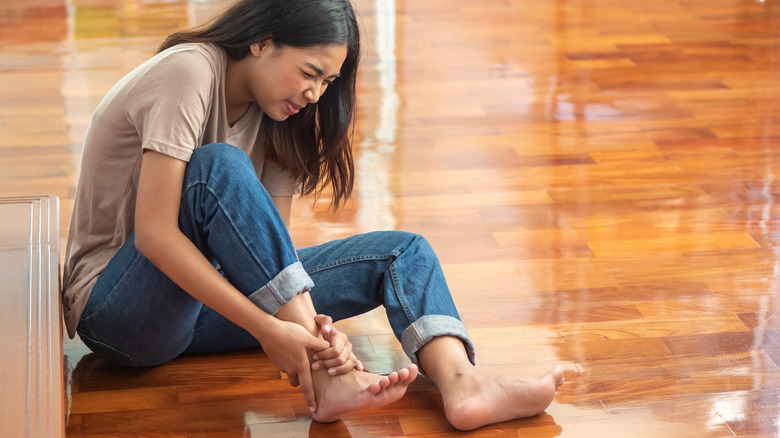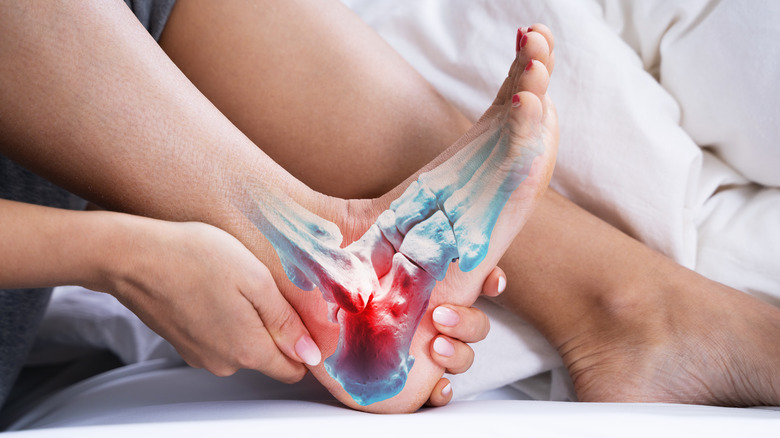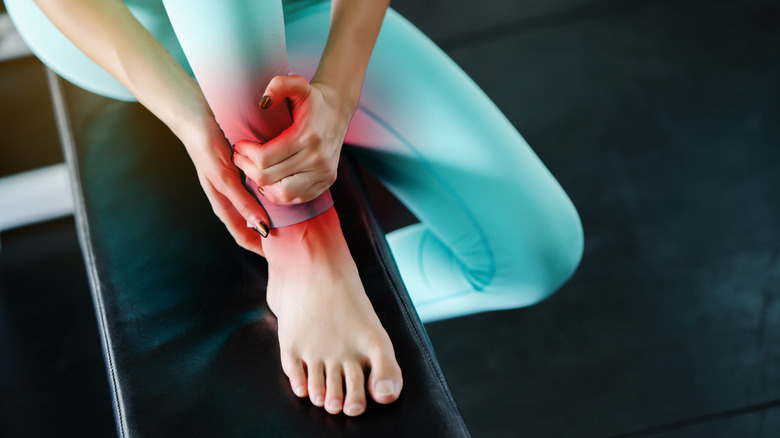What Does It Mean When Your Right Ankle Hurts
Imagine jogging in the park and thinking how good it feels, when suddenly your ankle begins to hurt. You might think you have broken a bone or pulled a muscle, but that's not necessarily the case. Sometimes, right ankle pain is due to Achilles tendinitis, joint inflammation, or stress fractures, notes the Mayo Clinic. Other times, it may result from prolonged sitting or standing. Ill-fitting shoes may cause aches and pain, too.
The foot and ankle are complex anatomical structures consisting of bones, joints, tendons, muscles, and ligaments. An injury to any of these structures can cause pain and limit your range of motion. Ankle sprains, for example, tend to affect the anterior talofibular ligament, explains Orthopaedia. This band of connective tissue connects the end of your calf bone to the talus, a small bone in the ankle. However, you may also experience ankle pain if you injure the nerves and muscles in your foot or lower leg.
So, what does it mean when your right ankle hurts? Could it be an overuse injury or something more serious, such as arthritis? Let's find out.
Common causes of right ankle pain
Pain in the right ankle may be due to bursitis, plantar fasciitis, stress fractures, sprains, strains, and everything in between, says the Mayo Clinic. Bursitis, or joint inflammation, causes swelling, redness, and sensitivity to touch. You may also experience dull, aching pain in the affected area. Ankle bursitis typically occurs because of a tendon problem. Therefore, it's important to address that problem and not just your symptoms, explains Versus Arthritis. This condition isn't a medical emergency, but you should seek help if you're having a fever, chills, or sharp pain in the joint as well.
Most injuries affecting the ankle have specific symptoms. Achilles tendonitis, for instance, may cause pain in the ankle and heel when you're standing on your tiptoes. A broken ankle, on the other hand, can affect your ability to walk. You might also hear a popping or snapping sound when the injury occurs, according to the UK's National Health Service. The pain will be sharp and immediate, and your ankle may look out of place.
Another common cause of right ankle pain is arthritis. Its symptoms tend to flare up in the morning and during exercise, as well as after long periods of sitting, notes the American Academy of Orthopaedic Surgeons (AAOS). In addition to pain, you may notice joint swelling, redness, and stiffness. While there is no cure for this disease, it can be managed through lifestyle changes, such as filling up on foods that fight inflammation. Physical therapy and medications may help, too. Surgery is only recommended in severe cases.
How to relieve ankle pain and prevent it from getting worse
Ankle pain often goes away on its own, especially if you're having a minor injury. Versus Arthritis recommends using the RICE method along with a gentle massage. The acronym RICE stands for rest, ice, compression, and elevation. Simply put, you need to rest your ankle for a couple of days and apply ice packs for 20 minutes every few hours. Wrap a bandage around the affected area and keep your lower leg elevated while in bed to reduce swelling.
What matters most is to give your body enough time to heal. You may continue to exercise, but it's best to avoid activities like running, jogging, and squatting until you've fully recovered. "A common mistake that many people make is to stop rehab too soon. They assume that just because they've got back to the stage where they're pain-free, that this means that the injury is now 100% recovered — when in fact, it isn't," says physiotherapist Ant Brightwell (via Runner's World). She also points out that running with an ankle injury may cause problems in other parts of the body.
Note that it's perfectly fine to stretch your ankle and foot. Stretching helps maintain your mobility and increases blood flow to the muscles. As your injury heals, try to gradually incorporate calf raises and other gentle exercises into your workout. Focus on strengthening the muscles in your lower leg, ankle, and foot, recommends the AAOS.


